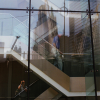postmortem
In Latin, the term literally means "after death." In a medical context, postmortem refers to a thorough examination of a dead body in order to determine the cause and circumstances of death. Autopsy, which is the surgical dissection of the body, can be part of this examination, but it is not always necessary.










